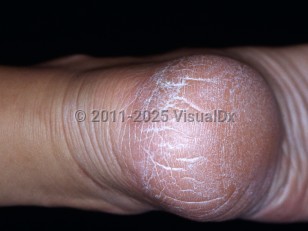Heel fissure in Adult
Alerts and Notices
Important News & Links
Synopsis

Heel fissures (cracked heels) are splits of the epidermis and stratum corneum that occur in many individuals as a consequence of excessive dryness (xerosis) and thickening of the skin. Heel fissures also develop in callused skin. Skin fissures are especially common in winter, when dry cold air is made even drier by indoor heating. The elderly population is at particular risk. In some people, heel fissures occur year round. It should be noted that air conditioning not only cools the air but dries it as well. Because of this, "winter itch" and dryness can even occur in the summer.
People with atopic dermatitis are at higher risk for heel fissures. Other risk factors that may predispose to this condition include obesity, prolonged standing, and wearing open-backed shoes or sandals. Heel fissures can be very uncomfortable and are often painful. Rarely, fissures can provide a portal of entry for secondary bacterial infection. Heel fissures can also develop in other skin conditions such as juvenile plantar dermatosis, pityriasis rubra pilaris, and psoriasis. Heel fissures are of particular concern in individuals with diabetes, as they can lead to slowly healing ulcers and secondary infection.
People with atopic dermatitis are at higher risk for heel fissures. Other risk factors that may predispose to this condition include obesity, prolonged standing, and wearing open-backed shoes or sandals. Heel fissures can be very uncomfortable and are often painful. Rarely, fissures can provide a portal of entry for secondary bacterial infection. Heel fissures can also develop in other skin conditions such as juvenile plantar dermatosis, pityriasis rubra pilaris, and psoriasis. Heel fissures are of particular concern in individuals with diabetes, as they can lead to slowly healing ulcers and secondary infection.
Codes
ICD10CM:
L98.8 – Other specified disorders of the skin and subcutaneous tissue
SNOMEDCT:
95321009 – Fissure in skin
L98.8 – Other specified disorders of the skin and subcutaneous tissue
SNOMEDCT:
95321009 – Fissure in skin
Look For
Subscription Required
Diagnostic Pearls
Subscription Required
Differential Diagnosis & Pitfalls

To perform a comparison, select diagnoses from the classic differential
Subscription Required
Best Tests
Subscription Required
Management Pearls
Subscription Required
Therapy
Subscription Required
References
Subscription Required
Last Updated:08/06/2023
 Patient Information for Heel fissure in Adult
Patient Information for Heel fissure in Adult
Premium Feature
VisualDx Patient Handouts
Available in the Elite package
- Improve treatment compliance
- Reduce after-hours questions
- Increase patient engagement and satisfaction
- Written in clear, easy-to-understand language. No confusing jargon.
- Available in English and Spanish
- Print out or email directly to your patient
Upgrade Today

Heel fissure in Adult

